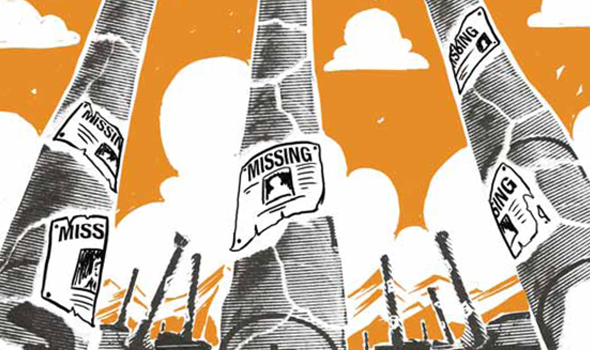How do men picked up by security forces and detained in custody, disappear for years without an official explanation, then magically emerge as militants? If the Jammu and Kashmir government is to be believed, that is precisely what has happened with these cases which have come to be known as ‘enforced disappearances’. Chief minister Omar Abdullah, on June 5, said that the return of youth under Rehabilitation Policy for those who crossed the border in the last two decades, enamoured by the gun, but had no cases registered against them, would also help solve the issue to a greater extent. He maintained that many of them had crossed the LoC during the period of disturbance but did not resort to violence, and wanted to return and live a peaceful life. But the remarks have been vehemently opposed by the Association of Parents of Disappeared Persons (APDP) which maintains that Omar Abdullah is lying. “CM is trying to shield himself by saying all this,” Parveena Ahangar, president of the APDP, said during a sit-in dharna on June 10, adding, “Our dear ones have been taken by Rashtriya Rifles, CRPF, Ikhwanis (surrendered militants co-opted by various security agencies) and army. They have not gone to Pakistan.”
For two decades, the APDP, comprising mainly women – mothers, sisters and wives of disappeared men – has been struggling to uncover the truth through agitations and legal procedures. In some of the cases, the courts have directed the concerned security agencies to respond and find the whereabouts of these missing men, but the latter have completely ignored the court’s directives. The cases have been pending disposal in courts for years without an inkling of how these men vanished in custody of the security forces in a heavily militarized Kashmir. And now, the bizarre: they have emerged as men who went across the borders for arms training or returned as militants, or as men who renounced violence and wish to come back to their homes and settle as ordinary citizens.
“For two decades, the APDP, comprising mainly women – mothers, sisters and wives of disappeared men – has been struggling to uncover the truth through agitations and legal procedures.”
There seems a certain method in the madness of Omar Abdullah’s remarks. In March, following several militant attacks including a fidayeen attack that killed 6 CRPF men and injured several others including some civilians, news reports emerged in a section of media quoting ‘highly placed police sources’ that Showkat Ahmad Pal, a man who is believed to have disappeared in custody for a decade is suspected to be part of a fidayeen squad preparing for an attack in the Civil Lines area of Srinagar. Showkat was a college student and a part time reporter with a local newspaper in June 2003 when he was allegedly abducted by Major Pratap of Kiloo Force, 2 Rashtriya Rifles (RR) stationed at Sharief Abad, HMT, Srinagar from Pratap Park, Lal Chowk in the heart of the summer capital. Almost two years later, on the directions of CJM Srinagar, the SHO, Police Station Kothibagh, Srinagar registered the FIR on January 18, 2005. A Special Investigation Team (SIT) appointed to investigate the FIR has recorded the statement of the source of Major Pratap, namely Khursheed Ahmad, who had confirmed that Showkat was taken into illegal custody by major Pratap. However, even after filing of FIR, investigation in the matter of the disappearance of Showkat Ahmad Pal has not been conducted and concluded till date.
The recent news report, planted by a police official who remains anonymous, raises several questions. How did Showkat disappear in custody and join the militant groups? Was he released? Did he escape prison? Was he handed over to the militant groups to be converted into a fidayeen? And, why is there still no official truth about his mysterious disappearance even as the counter intelligence of Kashmir admitted he was detained? Following the report, Showkat Pal’s parents, Farida and Abdul Rehman Pal, members of the APDP, say they were harassed by security agencies and fear for the safety of their disappeared son. And so they decided to move the state high court in April. The Jammu and Kashmir High Court has directed the police to present all case diaries related to the disappearance of Showkat Ahmad Pal, but so far, these have not been submitted before the court.
So, where does the truth lie? Some years ago, the International People’s Tribunal on Human Rights and Justice (IPTK) came out with the shocking report ‘Buried Evidence’ of 2700 unknown, unmarked mass graves, containing 2943 bodies, across 55 villages in just a couple of North Kashmir’s districts. The State Human Rights Commission took cognizance of this report and ordered an investigation, whose report revealed that the SHRC investigation panel admitted to there being 2156 graves in 38 graveyards. When the IPTK came out with the report in December 2008, it maintained that the graves may belong to the people who have been missing in custody for years. SHRC report almost endorsed that view, seeking a full investigation with DNA profiling of all the persons buried in the graves as well as of the families of the missing men. However, the APDP begs to differ. It is unwilling to believe that their missing men are dead and lie in these graves. Parveena maintains that while there is likelihood that some missing men may have been killed in fake encounters and passed off as foreign militants, and may be lying in those graves, there is also a possibility that some of these graves do belong to unidentified foreign ultras who came from across the borders.
So where are these missing men? Have they been killed in fake encounters? Are they lying in the missing graves, with just mounds of earth to cover them and tagged with a number? Have they become part of some fidayeen squads? Or are they waiting across the forbidden Line of Control to return to their homes? There may be only one way to unravel the mystery. As Parveena avers, “Ask those men who picked up our sons. Only they know what happened to them.” She questions why they haven’t been interrogated till date, even as in many of the cases, these security officials stand identified, as in the case of her own son, Javed Ahangar, who disappeared in 1991.
The latest mysteries around these missing men go beyond the usual paradigm of ‘tragedy and trauma’. They portend a dangerous trend. The chief minister wants people to believe that some disappeared men may be alive across the border, waiting to seek benefit of amnesty and rehabilitation policy, as did Liyaqat Shah, nabbed at the Indo-Nepal borders in February earlier this year, charged with being a part of a fidayeen gang, and later released on bail. Some police officials maintain that one of the missing men is part of a fidayeen squad. Is it a matter of coincidence or is there a greater co-relation between the rehabilitation policy and the fictions being weaved around the fidayeen phenomena, greater co-relation between the security agencies and their concocted ‘fidayeen’?
These incidents also coincide with the revelations of a cop running a militants module, luring youth to go for arms training and then using them for militant attacks or killing them in encounters. How deep is the involvement of the security agencies and the police in luring youth towards the gun, apart from the usual forms of brutalisation that often pushes them towards the option? Are these just aberrations, stemming from misadventures of some individuals in uniform or is there a larger system in place? Last year’s shocking revelations made in a book Meadow: Where the terror began by two foreign journalists, pointed out the problems of the counter insurgency policy that perpetuates more violence and terror by officially patronizing gunmen and incidents of arson. It is not difficult to imagine the dangerous repercussions of such a policy by simply looking at the present fate of Pakistan, where its adventurous army and the ISI is now unable to rein in the monsters they unleashed a decade or so ago.
Given the recent history of Kashmir and absolute disillusionment of the youth in peaceful forms of resistance, and given the spurt in incidents of militancy, it is likely that the gun may soon make a comeback in the Valley of sorrows, in a far more lethal form than it did two decades ago. It would be impossible to stop it without a fair assessment of the extent of involvement of the security agencies in the making of a militant.














